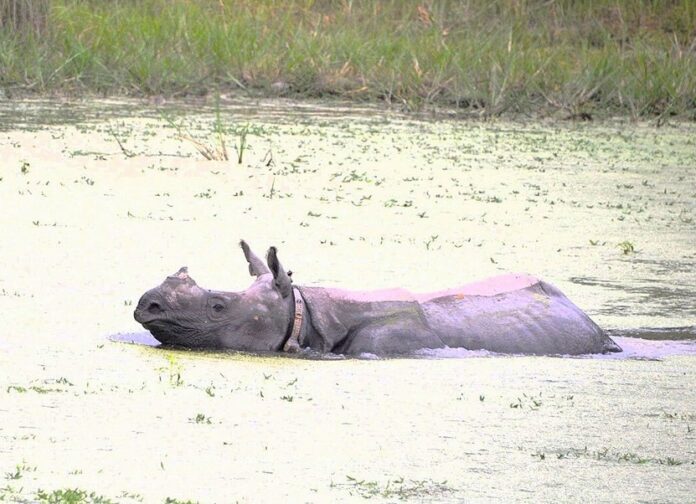Rhinoceros unicornis L. The Dudhwa relocation -A success story.
- The greater one-horned rhino (or Indian Rhino) Rhinoceros unicornis is the largest of the rhino species which was once distributed across the whole of the northern part of the Indian subcontinent. Hunted for sports or killed as agricultural pests, the species was almost put close to extinction by the advent of the 20th century with only about 200 Rhinos in the wild. Conservation efforts have now witnessed a spectacular recovery with almost 4000 rhinos currently reported from the north eastern parts of India and the Terai grasslands of Nepal.
- Inhabiting the tropical and subtropical grasslands, savannahs and shrublands, the Indian Rhino is characterised by a single black horn about 8 to 25 inches long and a grey -brown hide with skin folds giving it an armour-plated appearance.
- The species is solitary but adult males or adolescent rhinos may gather at wallows or to graze. Ranges are loosely defined and often overlap. They mark their territories, faeces and glandular secretions. The diet consists mainly of grasses, leaves, branches of shrubs and trees, fruits and aquatic plants.
- The Indian Rhinoceros is about 5.75-6.75 feet in height, 1800 to 2700 Kg. in weight and 10-12.5 feet long. Although the folds of the skin look like armour, yet they are very soft and susceptible to cuts and bruises. The eye sight is poor but the sense of hearing and smell is greatly developed.
- Females become sexually mature at 5 to 7 years while males mature at 10. Breeding occurs throughout the year. The gestation period is 15 to 16 months. The calf remains with the mother for 1 to 3 years until the birth of another calf.
- An interesting feature of the great Indian Rhino is that it shares common defecation spots called ‘middens’ where dung may be found in heaps almost as high as 3 meters. They return to the same heap to defecate. These heaps allow them to leave behind information for other rhinos to read. This information base may relate to the age of the animal, the sex, oestrus status etc.
Conservation Initiatives and the Dudhwa National Park
- Currently there are only five species of family Rhinocerotidae in the world, two found in southern and Eastern Africa and Three in tropical Asia. Several dozen genera have become extinct over the ages. Rhinoceros (Rhino to mean ‘nose’ in Greek and ceros to mean ‘horn’ in Greek), like animals, having a horn on their nose have an evolutionary history of about 60 million years. All the five extant species are threatened. Indian Rhino has been included in Schedule-1 of the Wild Life Act 1972.
- Dudhwa National Park located at Lakhimpur Kheri in Uttar Pradesh, India, became the first park in India where several Greater one horned Rhinoceros (Rhinoceros unicornis L.) were relocated in 1984 in order to bring back the Rhino population which had been wiped off due to poaching specially for horns and habitat loss. Starting with just 5 Rhinos, it has 46 Rhinos in all within an enclosure. In breading is an issue. Rhinos were sourced from the Kaziranga National Park and the Pobitora Wildlife Sanctuary in Assam, India.
- In order to ensure gene diversity and facilitate mating with Rhinos coming across the border from Nepal, 4 Rhinos have been released in the wild in November 2024 and March 2025.
- The Rhinos have been radio collared to ensure future monitoring. A plan is underway to release a limited number of rhinos of Dudhwa into the open.
- The translocation exercise will help to reestablish the population of rhinos in the wild, expand their habitat and reduce the risk of in breeding.
©Srimaa Communication
Credits- Dr. Yashpal Singh, Mrs. Neena Singh, Manoj Kumar Yadav
